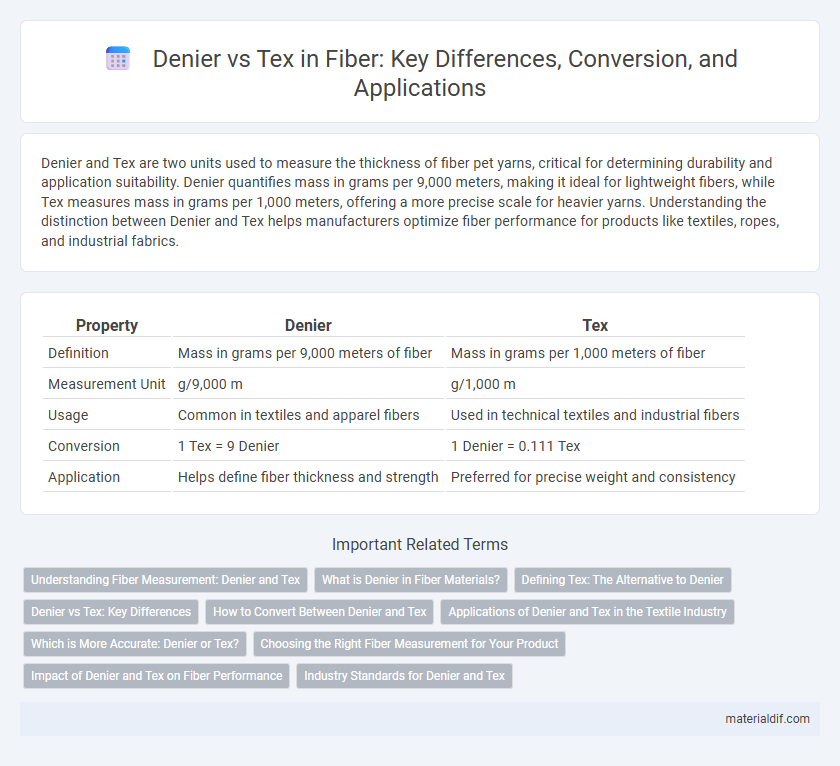Denier and Tex are two units used to measure the thickness of fiber pet yarns, critical for determining durability and application suitability. Denier quantifies mass in grams per 9,000 meters, making it ideal for lightweight fibers, while Tex measures mass in grams per 1,000 meters, offering a more precise scale for heavier yarns. Understanding the distinction between Denier and Tex helps manufacturers optimize fiber performance for products like textiles, ropes, and industrial fabrics.
Table of Comparison
| Property | Denier | Tex |
|---|---|---|
| Definition | Mass in grams per 9,000 meters of fiber | Mass in grams per 1,000 meters of fiber |
| Measurement Unit | g/9,000 m | g/1,000 m |
| Usage | Common in textiles and apparel fibers | Used in technical textiles and industrial fibers |
| Conversion | 1 Tex = 9 Denier | 1 Denier = 0.111 Tex |
| Application | Helps define fiber thickness and strength | Preferred for precise weight and consistency |
Understanding Fiber Measurement: Denier and Tex
Denier and Tex are both units used to measure the linear density of fibers, quantifying the mass per unit length to assess fiber thickness. Denier measures the mass in grams per 9,000 meters, commonly used in textile industries to describe fine fibers like nylon and polyester. Tex measures grams per 1,000 meters, providing a standardized metric ideal for comparing fiber weights across various materials, with Tex values typically lower than denier for the same fiber thickness.
What is Denier in Fiber Materials?
Denier is a unit of measurement for the linear mass density of fibers, representing the weight in grams of 9,000 meters of the fiber. It indicates the thickness of individual fibers, where a higher denier number corresponds to a thicker and heavier fiber. This measurement is crucial for determining the strength, durability, and texture of fabrics in textile manufacturing.
Defining Tex: The Alternative to Denier
Tex is a metric unit measuring the linear mass density of fibers, defined as grams per 1,000 meters, offering a standardized alternative to Denier, which measures grams per 9,000 meters. Tex provides greater precision for textile engineers and manufacturers by directly correlating fiber weight to length without conversion factors, simplifying calculations in fabric production. This uniform metric measurement facilitates international trade and quality control in the fiber and textile industries, improving consistency across different markets.
Denier vs Tex: Key Differences
Denier measures fiber thickness by the weight in grams of 9,000 meters of yarn, while Tex measures the weight in grams of 1,000 meters of yarn. Denier is commonly used in the textile and apparel industries to indicate fiber fineness, whereas Tex offers a more direct and consistent unit suitable for technical and industrial applications. Understanding the key differences between Denier and Tex is crucial for selecting appropriate fibers based on strength, durability, and fabric weight requirements.
How to Convert Between Denier and Tex
To convert between Denier and Tex, use the formula where 1 Tex equals 9 Denier, meaning Tex is the weight in grams per 1000 meters of fiber, and Denier is the weight in grams per 9000 meters. For converting Denier to Tex, divide the Denier value by 9; for Tex to Denier, multiply the Tex value by 9. Understanding these conversions enables precise measurement and comparison of fiber thickness in textile manufacturing and quality control.
Applications of Denier and Tex in the Textile Industry
Denier and Tex are essential units for measuring fiber thickness, directly influencing fabric performance in the textile industry. Denier is commonly applied in the production of lightweight fabrics such as hosiery and lingerie, where fine, delicate yarns are required. Tex is preferred in industrial textiles like upholstery and technical fabrics, where precise control over thread linear density ensures durability and strength.
Which is More Accurate: Denier or Tex?
Tex is generally more accurate than Denier for measuring fiber linear density because it directly quantifies the mass in grams per 1,000 meters of fiber length, allowing for consistent comparisons across various material types. Denier measures the mass in grams per 9,000 meters, which can introduce variability depending on fiber length and is less precise for fine fibers. For technical textiles and performance evaluation, Tex is preferred due to its straightforward relationship between mass and length, providing a reliable standard for fiber classification.
Choosing the Right Fiber Measurement for Your Product
Denier and Tex are key units for measuring fiber thickness, where Denier quantifies the mass in grams per 9,000 meters of fiber and Tex measures grams per 1,000 meters, offering precise control over fiber weight in textile applications. Selecting the appropriate measurement depends on industry standards and product requirements, with Denier favored in North America for apparel fibers and Tex commonly used in Europe and technical textiles for detailed weight assessment. Understanding these units helps manufacturers optimize fiber properties, ensuring consistent fabric strength, texture, and durability tailored to specific end-use products.
Impact of Denier and Tex on Fiber Performance
Denier and tex are critical textile measurements that influence fiber performance by quantifying yarn thickness; denier measures grams per 9,000 meters while tex measures grams per 1,000 meters. Higher denier and tex values indicate thicker, stronger fibers with increased durability and abrasion resistance, essential for heavy-duty applications. Conversely, lower denier and tex fibers provide finer yarns with enhanced flexibility, softness, and breathability, benefiting lightweight and high-performance fabrics.
Industry Standards for Denier and Tex
Industry standards for denier and tex provide precise measurements critical for fiber quality and application. Denier quantifies fiber mass in grams per 9,000 meters, often used in textile industries to classify filament fineness, while tex measures mass in grams per 1,000 meters, favored in technical and industrial fiber sectors for its metric clarity. Both standards enable manufacturers to maintain consistency in yarn thickness, ensuring optimal performance in products such as fabrics, ropes, and composites.
Denier vs Tex Infographic

 materialdif.com
materialdif.com